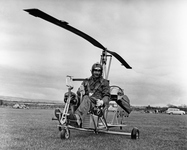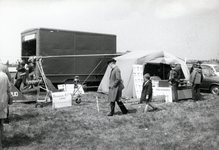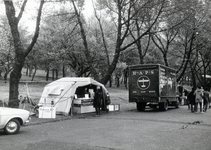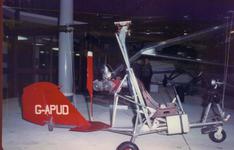GYROCOPTER - BENSON B7MC G-APUD (C/N 01)
The autogyro which joined the Northern Aircraft Preservation Society's collection in April 1972 is, perhaps, not significant in size, nor did it have a particularly long or distinguished flying career but it is regarded as a very worthy exhibit, principally on account of the pioneering work which was performed on it.
The Bensen B-7 was a small rotor kite developed by Igor Bensen in the United States in the 1950s and marketed for home building. It was a refined to be a slightly larger version of the B-6, replacing the skids with a tricycle undercarriage, and adding a single large fin to the rear of the aircraft. Extract from Wikipedia.
The B-7 was first towed aloft on 17 June 1955, and on 6 December that year, Bensen flew a motorized version designated the B-7M, a fully autonomous autogyro. The prototype B-7M crashed three days later with Bensen at the controls. Although the machine was soon repaired and in the air again, the incident set Bensen to work on further refinements to the design that would eventually lead to the B-8. Extract from Wikipedia
The Collections Gyrocopter was built in the UK by Ken Wallis and modified to a B7MC, instead of the overhead control yoke associated with Bensen Gyrocopters Ken Wallis used a joystick and is also reputed to have used a Supermarine Spitfire seat. There are few pictures of this machine in the air (so far the author has only found one). Extract from Wikipedia.
In 1957 Wing Commander K.H. Wallis decided to put into tangible form the ideas on rotary-wing flight which he had been forming since studying the wartime Hafner designs and the German Focke-Achgelis FA 330 rotor-kite which operated from the decks of hunting U-boats. Wing Commander Wallis was not the first of his family to experiment in light aviation as his father and uncle had, as early as 1910 built and exhibited the Wallbro Monoplane in the Cambridge area and, before joining the Royal Air Force, he made his own initial experiments in construction with a Flying Flea. The prudence and regard for safety which characterised his later work brought these experiments to a halt after the series of incidents which brought the Mignet design into some disrepute.
To test out his ideas, Wing Commander Wallis obtained the plans for a Bensen B-7 and, although his expertise in machining and welding enabled him to build the aircraft, it must be made plain that 'PUD was not built to a Wallis design but was rather a feasibility study for later original work. That original work was sufficiently notable for the experimental vehicle to be regarded as eminently worthy of preservation and it is of some interest that, alongside the autogyro in the N.A.P.S. collection are examples of both the Flying Flea and also the FA 330 which had interested Wing Commander Wall is when he made his initial studies.
With a solid background of Service engineering, Wallis is incorporated in the structure of the B-7 aircraft quality released materials of British Standards but kept largely to the original plans. However, a number of changes to the engineering design were made and the 'umbrella' sense controls were deleted, to be replaced by an orthodox control column operating through differential push-pull rods. This modification subsequently achieved universal use and a number of the changes made were ultimately accepted as standard for later Bensen autogyros.
Always regarded as a stepping-stone to more sophisticated designs concurrently being prepared, G-APUD flew for a short time and, if nothing else, was instrumental in drawing attention to aspects of design which would be eradicated when the prototype of the true Wallis autogyros was built. Performance left a lot to be desired and take-off in conditions of no wind was often impossible. There was an understandable thrill for the pilot who had put together so unusual a home-built machine but a number of features, including a fluctuating level of vibration and some problems of control and stability, led to the voluntary grounding of the aircraft as work on the new WA.116 progressed,
Already a decade has passed and the Wallis-designed autogyros are well-known, both in the aviation world and to a surprisingly wide cross-section of the Great British Public. Since its acquisition, G-APUD has attracted considerable interest at displays at Speke and Squire's Gate and the Northern Aircraft Preservation Society are delighted to have it - and with it the interest and encouragement of its builder!
Technical Data
Engine McCulloch 4318AX flat-four piston engine, 72 hp (54 kW)
Dimensions Height 6 ft 3 in (1.90 m), Length 11 ft 3 in (3.43 m)
Performance Cruising Speed 55 mph (137 km/h)
Initial Climb 1,000 ft/min (5.1 m/s)
Maximum Altitude 12,500 ft (3,800 m)
Range 100 miles (160 km)



